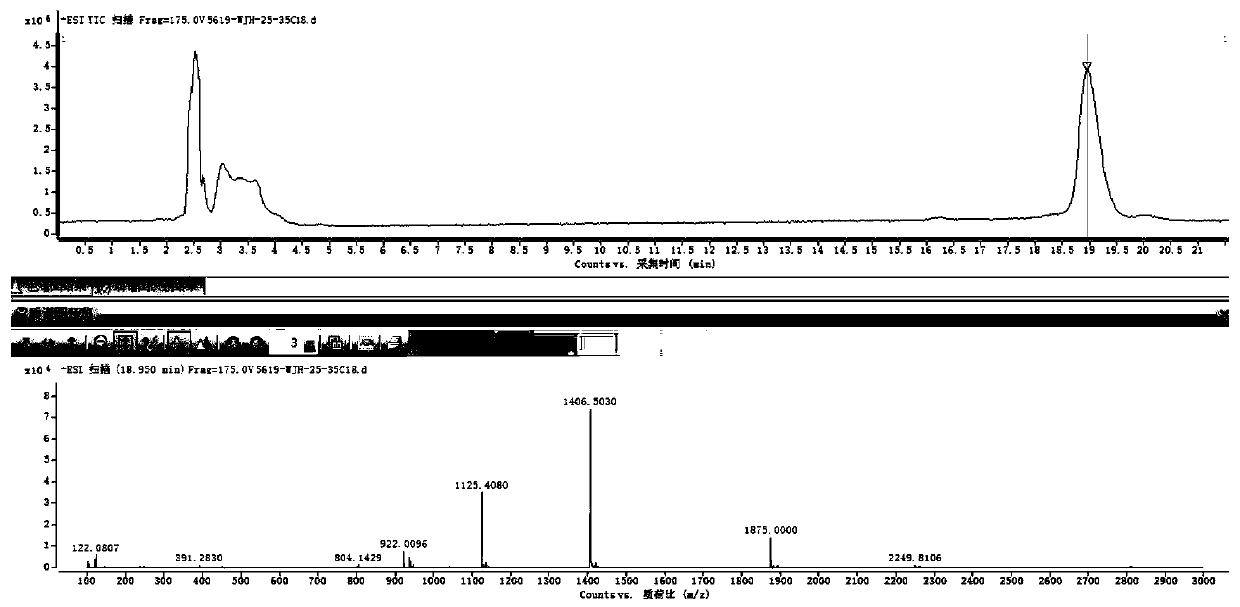Periplaneta americana tissue repair factor PA1 and application thereof
A technology of tissue repair and Periplaneta americana, which is applied to the peptide "tissue repair factor PA1" that promotes tissue repair and its application field, which can solve the problems of active ingredients that need to be studied in depth, and achieve a product that is easy to prepare in large quantities, promotes migration, and removes wrinkles Effect
- Summary
- Abstract
- Description
- Claims
- Application Information
AI Technical Summary
Problems solved by technology
Method used
Image
Examples
Embodiment 1
[0042] Example 1 Isolation and structure identification of tissue repair factor PA1
[0043] (1) Periplaneta americana medicinal material 1kg, crushed into coarse powder, extracted by percolation with 3 times the mass of 80% (v / v) ethanol solution 3 times, each time for 24 hours; combined extracts, concentrated under reduced pressure to thick paste 200 ~300mL, add 10~15 times the volume of hot water (70°C), keep it warm for 12 hours, separate layers, and discard the upper layer of oil. After the aqueous solution was concentrated, it was loaded on a reversed-phase C-18 chromatographic column, and 6 column volumes were first eluted with 30% methanol by volume, and then 6 column volumes were eluted with 50% and 75% methanol aqueous solutions by volume percentage, and then 6 column volumes were eluted with HPLC-MS analysis followed detection, collected the fractions mainly containing polypeptide compounds, combined the fractions, concentrated under reduced pressure or vacuum dried...
Embodiment 2
[0052] Example 2 Solid phase synthesis of tissue repair factor PA1
[0053] The conventional solid-phase synthesis method of peptide synthesizer is used to complete the synthesis of tissue repair factor PA1 through the processes of resin swelling, deprotection, washing, amino acid dissolution, amino acid activation, condensation, and cutting. The method of liquid phase-mass spectrometry was used to compare the synthesized and isolated tissue repair factor PA1 samples, and the results showed that their retention times and molecular weights were consistent ( Figure 8 ).
Embodiment 3
[0054] Example 3 Promoting effect of tissue repair factor PA1 on the proliferation of Balb / c 3T3 cells
[0055] Cells in the logarithmic growth phase (Balb / c 3T3 cell line, purchased from the American Type Culture Collection, ATCC) were digested with trypsin, centrifuged, and resuspended for cell counting, counted as 10,000 cells Inoculate each well in a 96-well plate, tap until the cells are evenly dispersed, and block with PBS. 37°C, 5% CO 2 Incubate overnight. After the cells adhered to the wall, the original medium was discarded, and then DMEM medium (containing 10% fetal bovine serum) containing different concentrations of "tissue repair factor PA1" was added, at 37°C, 5% CO 2 Incubate in the incubator for 24h. Add 30 μL of MTT solution to each well, continue to incubate for 4 h, discard the upper layer of MTT, add 100 μL of DMSO to each well, shake for 10 min to fully dissolve the crystals, and measure the OD value of each well at 570 nm with an enzyme-linked immunoso...
PUM
 Login to View More
Login to View More Abstract
Description
Claims
Application Information
 Login to View More
Login to View More - R&D
- Intellectual Property
- Life Sciences
- Materials
- Tech Scout
- Unparalleled Data Quality
- Higher Quality Content
- 60% Fewer Hallucinations
Browse by: Latest US Patents, China's latest patents, Technical Efficacy Thesaurus, Application Domain, Technology Topic, Popular Technical Reports.
© 2025 PatSnap. All rights reserved.Legal|Privacy policy|Modern Slavery Act Transparency Statement|Sitemap|About US| Contact US: help@patsnap.com



